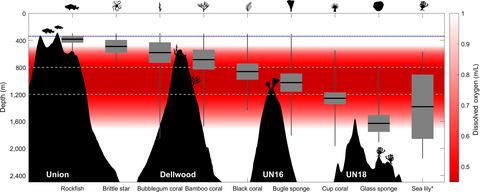当前位置:
X-MOL 学术
›
Glob. Change Biol.
›
论文详情
Our official English website, www.x-mol.net, welcomes your
feedback! (Note: you will need to create a separate account there.)
Rapid deep ocean deoxygenation and acidification threaten life on Northeast Pacific seamounts.
Global Change Biology ( IF 10.8 ) Pub Date : 2020-08-10 , DOI: 10.1111/gcb.15307 Tetjana Ross 1 , Cherisse Du Preez 1 , Debby Ianson 1
Global Change Biology ( IF 10.8 ) Pub Date : 2020-08-10 , DOI: 10.1111/gcb.15307 Tetjana Ross 1 , Cherisse Du Preez 1 , Debby Ianson 1
Affiliation

|
Anthropogenic climate change is causing our oceans to lose oxygen and become more acidic at an unprecedented rate, threatening marine ecosystems and their associated animals. In deep‐sea environments, where conditions have typically changed over geological timescales, the associated animals, adapted to these stable conditions, are expected to be highly vulnerable to any change or direct human impact. Our study coalesces one of the longest deep‐sea observational oceanographic time series, reaching back to the 1960s, with a modern visual survey that characterizes almost two vertical kilometers of benthic seamount ecosystems. Based on our new and rigorous analysis of the Line P oceanographic monitoring data, the upper 3,000 m of the Northeast Pacific (NEP) has lost 15% of its oxygen in the last 60 years. Over that time, the oxygen minimum zone (OMZ), ranging between approximately 480 and 1,700 m, has expanded at a rate of 3.0 ± 0.7 m/year (due to deepening at the bottom). Additionally, carbonate saturation horizons above the OMZ have been shoaling at a rate of 1–2 m/year since the 1980s. Based on our visual surveys of four NEP seamounts, these deep‐sea features support ecologically important taxa typified by long life spans, slow growth rates, and limited mobility, including habitat‐forming cold water corals and sponges, echinoderms, and fish. By examining the changing conditions within the narrow realized bathymetric niches for a subset of vulnerable populations, we resolve chemical trends that are rapid in comparison to the life span of the taxa and detrimental to their survival. If these trends continue as they have over the last three to six decades, they threaten to diminish regional seamount ecosystem diversity and cause local extinctions. This study highlights the importance of mitigating direct human impacts as species continue to suffer environmental changes beyond our immediate control.
中文翻译:

深海快速脱氧和酸化威胁着东北太平洋海山的生命。
人为气候变化正在导致我们的海洋以前所未有的速度失去氧气并变得更加酸性,威胁着海洋生态系统及其相关动物。在深海环境中,条件通常会随着地质时间尺度的变化而变化,适应这些稳定条件的相关动物预计非常容易受到任何变化或直接人类影响。我们的研究将最长的深海观测海洋学时间序列之一(可追溯到 20 世纪 60 年代)与现代目视调查相结合,该调查描绘了近两公里垂直的海底山生态系统。根据我们对 P 线海洋学监测数据的新的严格分析,东北太平洋 (NEP) 上层 3,000 米的氧气在过去 60 年中已经损失了 15%。在此期间,最低含氧区 (OMZ) 的范围约为 480 至 1,700 m,以每年 3.0 ± 0.7 m 的速度扩大(由于底部加深)。此外,自 20 世纪 80 年代以来,OMZ 上方的碳酸盐饱和层一直以每年 1-2 m 的速度变浅。根据我们对四个 NEP 海山的目视调查,这些深海特征支持了具有重要生态意义的类群,其特征是寿命长、生长速度慢和流动性有限,包括形成栖息地的冷水珊瑚和海绵、棘皮动物和鱼类。通过检查脆弱人群子集的狭窄测深生态位内的变化条件,我们解决了与类群寿命相比快速且对其生存有害的化学趋势。如果这些趋势像过去三到六十年那样持续下去,就有可能减少区域海山生态系统的多样性并导致局部物种灭绝。 这项研究强调了减轻人类直接影响的重要性,因为物种继续遭受我们无法直接控制的环境变化。
更新日期:2020-10-19
中文翻译:

深海快速脱氧和酸化威胁着东北太平洋海山的生命。
人为气候变化正在导致我们的海洋以前所未有的速度失去氧气并变得更加酸性,威胁着海洋生态系统及其相关动物。在深海环境中,条件通常会随着地质时间尺度的变化而变化,适应这些稳定条件的相关动物预计非常容易受到任何变化或直接人类影响。我们的研究将最长的深海观测海洋学时间序列之一(可追溯到 20 世纪 60 年代)与现代目视调查相结合,该调查描绘了近两公里垂直的海底山生态系统。根据我们对 P 线海洋学监测数据的新的严格分析,东北太平洋 (NEP) 上层 3,000 米的氧气在过去 60 年中已经损失了 15%。在此期间,最低含氧区 (OMZ) 的范围约为 480 至 1,700 m,以每年 3.0 ± 0.7 m 的速度扩大(由于底部加深)。此外,自 20 世纪 80 年代以来,OMZ 上方的碳酸盐饱和层一直以每年 1-2 m 的速度变浅。根据我们对四个 NEP 海山的目视调查,这些深海特征支持了具有重要生态意义的类群,其特征是寿命长、生长速度慢和流动性有限,包括形成栖息地的冷水珊瑚和海绵、棘皮动物和鱼类。通过检查脆弱人群子集的狭窄测深生态位内的变化条件,我们解决了与类群寿命相比快速且对其生存有害的化学趋势。如果这些趋势像过去三到六十年那样持续下去,就有可能减少区域海山生态系统的多样性并导致局部物种灭绝。 这项研究强调了减轻人类直接影响的重要性,因为物种继续遭受我们无法直接控制的环境变化。









































 京公网安备 11010802027423号
京公网安备 11010802027423号